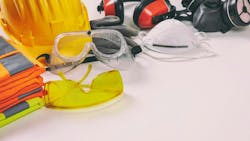The proper use of the correct personal protective equipment (PPE) under the right circumstances will prevent death and disfigurement. It will also prevent things like hearing loss, pulmonary fibrosis, and blindness. But PPE is not always properly used — and the PPE that is used is not always correct for the given circumstances. And sometimes, PPE is defective due to improper storage, improper handling, excess use, or age.
For example, a factory in western Tennessee had a large stamping operation in one area. That area was located in the back corner away from other operations. This alone reduced the need for hearing protection in most of the plant. An acoustically tiled wall further reduced the decibels of pounding sounds escaping from the stamping area. Additionally, strategically placed sound deadening material even reduced the decibel level inside the stamping area. That’s an example of reducing the total hazard to a more easily managed level. Even though it didn’t eliminate the need for hearing protection, it did reduce the reliance on PPE.
For those in the stamping area, this example illustrates the principle of reducing the magnitude of the hazard. For those in most of the plant, it illustrates eliminating the hazard (from this specific source). Here are three more illustrative examples:
- Fall protection is needed because the level controller has to be mounted near the top of the tank, so an extension ladder is required. Eliminate the fall hazard by constructing a platform from which to work and building a cage around it. Or reduce the fall hazard risk by installing guardrails if a cage isn’t practicable. Add a permanent ladder for access, eliminating ladder safety issues specific to extension ladders.
- Arc-rated clothing and related PPE are needed to perform infrared thermography on a critical breaker, because the panel must be open for the thermographer to scan that breaker. Does it really need to be open? Not if you install a thermographic window. Doing this eliminates exposure to live parts. You can make this even safer by determining the least costly thermographic camera capable of getting the information needed, and semi-permanently mounting it there so it would be a specific-use camera. A thermographer could set it up, then anybody could read the screen or access the images and data it transmits to your remote PC or other system.
- Insulated gloves are needed to perform maintenance on the control system for a particular production machine because it uses 120V solenoids and 120V relays. This system doesn’t have 120V temperature sensor wiring, so why do its control elements need to be 120V? A big justification for 120V controls is they are noise-immune. But so is a 4mA-20mA system, and it can’t give you a lethal shock. The cost of changing this over is probably not all that much because you’re replacing fairly inexpensive parts and some wiring. Plus, a 4mA-20mA system gives you additional capabilities you don’t have with a binary 120V system.
Now think of some examples in your own plant. Where can you reduce or eliminate specific hazards so that PPE is there “just in case” rather than there because you would definitely be harmed without it?
About the Author

Mark Lamendola
Mark is an expert in maintenance management, having racked up an impressive track record during his time working in the field. He also has extensive knowledge of, and practical expertise with, the National Electrical Code (NEC). Through his consulting business, he provides articles and training materials on electrical topics, specializing in making difficult subjects easy to understand and focusing on the practical aspects of electrical work.
Prior to starting his own business, Mark served as the Technical Editor on EC&M for six years, worked three years in nuclear maintenance, six years as a contract project engineer/project manager, three years as a systems engineer, and three years in plant maintenance management.
Mark earned an AAS degree from Rock Valley College, a BSEET from Columbia Pacific University, and an MBA from Lake Erie College. He’s also completed several related certifications over the years and even was formerly licensed as a Master Electrician. He is a Senior Member of the IEEE and past Chairman of the Kansas City Chapters of both the IEEE and the IEEE Computer Society. Mark also served as the program director for, a board member of, and webmaster of, the Midwest Chapter of the 7x24 Exchange. He has also held memberships with the following organizations: NETA, NFPA, International Association of Webmasters, and Institute of Certified Professional Managers.
